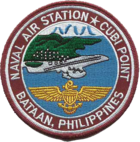- Naval Air Station Cubi Point
-
Naval Air Station Cubi Point
Naval Base Subic Bay
IATA: NCP – ICAO: RPMB Summary Airport type Naval Air Station Operator United States Navy Location Bataan, Philippines Built 1945 In use Decommissioned Commander n/a Coordinates 14°47′40.02″N 120°16′16.91″E / 14.79445°N 120.2713639°E Runways Direction Length Surface ft m 07L/25R 9,003 2,728 Asphalt U.S. Naval Air Station Cubi Point was a United States Navy aerial facility located at the edge of Naval Base Subic Bay and abutting the Bataan Peninsula in the Philippines.
Contents
History
The need for a naval air station was realized during the Korean War. Admiral Arthur W. Radford, Chief of Naval Operations conceived of the construction of a naval air station at Cubi Point, which was then a rugged and jungle covered finger of land 3 miles (4.8 km) from Subic Naval Base. He pictured the air station as a vital link in the defense of the Southwest Pacific.
In spite of the magnitude of the job and the tremendous difficulties the construction involved, the project was approved by The Pentagon. Civilian contractors were initially tapped to fulfill the project but after taking seeing the forbidding Zambales Mountains and the maze of jungle at Cubi Point, they claimed it could not be done. The Navy's Seabees were then given the project and in 1951, the Seabees began the first phase of the project. The first Seabees to arrive were MCB-3 on October 2, 1951; the second, MCB-5, arrived on November 5, 1951.
The first problem encountered was the transfer of an entire town. The town of Banicain stood on the site of the proposed airfield and so had to be moved to the community of Olongapo where it became New Banicain. The former Banicain now lies under 45 feet (14 m) of earth.
The next problem involved the moving of mountains and the building of a 10,000 feet (3,000 m) long airstrip that stretches out into Subic Bay, along the waterfront and out into the sea. It was one of the largest earthmoving projects in the world, equivalent to the construction of the Panama Canal.
In all, it took five years and an estimated 20-million man-hours to build this Navy base. At Cubi Point Seabees cut a mountain in half to make way for a nearly two-mile long runway. They blasted coral to fill a section of Subic Bay, filled swampland, moved trees as much as 150 feet (46 m) tall and six to eight feet in diameter, and relocated a native fishing village.
The $100 million facility was commissioned on July 25, 1956 and comprised an air station and an adjacent pier that was capable of docking the Navy's largest carriers.
On December 21, 1972, Naval Air Station Cubi Point honored Radford by changing the name of its airfield to Arthur W. Radford Field. Radford had the unusual honor of being able to make the dedication speech himself. The plaque reads:
"Dedicated in honor of Admiral Arthur W. Radford, whose foresight in founding U.S. Naval Air Station Cubi Point has enabled the United States Navy to provide invaluable support to the Seventh Fleet and to carry out its obligations under the Philippines-United States Mutual Defense Treaty."
At present Naval Air Station Cubi Point has been converted into a civil airport, and is known as Subic Bay International Airport.
Operations
Eventually, NAS Cubi Point served as the primary maintenance, repair and supply center for the 400 carrier-based aircraft of the Seventh Fleet's carrier force. During the Vietnam War, its jet engine shop turned out 2 jet engines a day to keep pace with demand.
NAS Cubi Point and Naval Base Subic Bay were also at the front lines during Operations Desert Storm and Desert Shield.
In June 1991, when Mt. Pinatubo, which was just 20 miles (32 km) from Subic Bay, erupted, NAS Cubi Point was blanketed in ash one-foot thick. After the evacuation of all dependents from the facility, an intense clean-up was begun to return the station to normal operations. Within two weeks, NAS Cubi Point was back in limited operation. Soon most building had electricity and water service restored. By mid-July, service had been restored to most family housing units.
By September, most dependents were back to Subic Bay and Cubi Point, but it was also in September that the Senate of the Philippines voted to have the United States withdraw from all of its facilities in the Philippines.
See also
- U.S. Naval Base Subic Bay
- U.S. Naval Station Sangley Point
- Subic Bay International Airport
- Military History of the Philippines
- Military History of the United States
References
External links
 Media related to Naval Air Station Cubi Point at Wikimedia CommonsCategories:
Media related to Naval Air Station Cubi Point at Wikimedia CommonsCategories:- Military installations of the Philippines
- United States naval air stations
- United States Navy bases
- Closed facilities of the United States Navy
- Airports established in 1956
Wikimedia Foundation. 2010.

